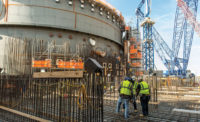

Southern Nuclear and Georgia Power were the latest nuclear energy providers to install a federally mandated disaster-resistant, concrete-dome equipment-storage facility designed to mitigate the loss of power in the event of an "extreme" natural phenomena. Unveiled at the utilities' Alvin W. Vogtle Electric Generating Plant, near Waynesboro, Ga., the so-called FLEX Dome was designed to withstand 360-mph winds—sufficient for a Category 5 hurricane or a direct hit from a tornado—as well as "event-driven missiles" or a seismic event, according to ABC Domes, which designed and built the structure.
The Vogtle installation is the latest deployment of a FLEX Dome at a U.S. nuclear site. The U.S. Nuclear Regulatory Commission, with input from the nuclear industry, developed the unit based the so-called Diverse and Flexible Mitigation Capability, or FLEX. In 2012, the NRC implemented the multi-pronged strategy to mitigate the potential impacts of "beyond-design-basis external events," such as the disaster at Japan's Fukushima Daiichi plant. In 2011, an earthquake-generated tsunami struck that nuclear facility, causing a loss of on-site and off-site power to the facility's safety cooling systems, resulting in a melting of the plant's three nuclear cores.
According to the NRC, "These additional requirements impose guidance and strategies to be available if the loss of power … affected all units at a site simultaneously."
Vogtle's dome is similar to others being deployed at other U.S. nuclear-plant sites. The 39-ft-tall facility will store portable generators, pumps, communication equipment, refueling equipment and other items. According to Southern Co. and Georgia Power, the equipment would be put to use only in the wake of a catastrophic event.
At approximately 15,000 sq ft, the facility at Vogtle will have plenty of storage space, says Tom Petrak, who oversees accident management at the plant.
"We will have enough equipment stored in the dome to cover both units for 72 hours after an event," Petrak said in a recent company video. Further, he estimated that, potentially, the equipment could last for as long as 30 days.
Earlier this year at a dome installation at the Plant Farley site in Alabama, Southern Nuclear CEO Steve Kuczynski told workers, "It's vitally important that we are able to show that we have taken tangible actions to address the learnings out of the Fukushima accident, which were many."
The facility's 2-ft-thick exterior walls are composed of steel rebar, polyurethane foam and 18 in. of shotcrete.



Post a comment to this article
Report Abusive Comment